Introduction: The Antwerp Context
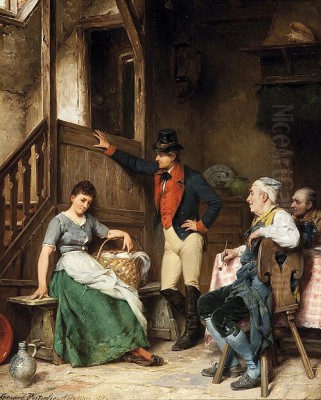
The latter half of the nineteenth century was a vibrant period for Belgian art, particularly in Antwerp. This bustling port city, with its rich artistic heritage stretching back to Rubens and Van Dyck, continued to foster significant talent. Antwerp's Royal Academy of Fine Arts remained a crucial institution, training generations of painters. Within this environment, artists explored various styles, from lingering Romanticism and historical painting to the burgeoning influences of Realism and, later, Impressionism and Symbolism. It was in this milieu that Gerard Jozef Portielje emerged as a distinctive voice, specializing in meticulously crafted genre scenes that captured the nuances of everyday life with charm and technical skill. He became part of an artistic family, contributing to a legacy that spanned multiple generations.
Gerard Jozef Portielje carved a niche for himself with paintings that appealed to the tastes of the bourgeoisie, depicting relatable scenes often imbued with gentle humour or quiet intimacy. His work stands as a testament to the enduring appeal of academic realism combined with a keen eye for narrative detail. While perhaps not as revolutionary as some of his contemporaries who pushed the boundaries of modernism, Portielje's dedication to craft and his ability to render textures, light, and human expression secured him a respectable place in Belgian art history. His paintings offer a window into the social customs, interiors, and quiet moments of his time.
Early Life and Artistic Formation
Gerard Jozef Portielje was born in Antwerp, Belgium, in 1856. He hailed from an artistic family, which undoubtedly influenced his career path. His father was Jan Frederik Pieter Portielje (1829–1908), himself a well-regarded painter primarily known for his portraits and genre scenes, often executed in a style influenced by Dutch Romanticism but adapted with French elegance. Growing up in such an environment likely provided Gerard Jozef with early exposure to artistic techniques and the professional life of a painter. Antwerp, with its active art market and prestigious Academy, offered fertile ground for a young artist.
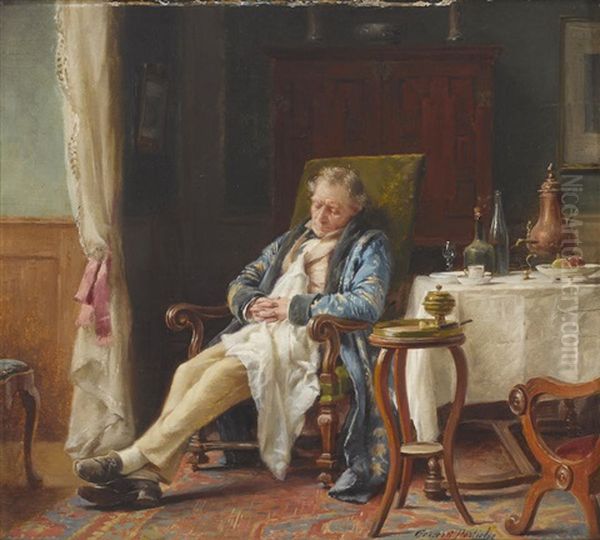
Following in his father's footsteps, Gerard Jozef enrolled at the renowned Royal Academy of Fine Arts in Antwerp. This institution provided rigorous training grounded in academic principles, emphasizing drawing, composition, and the study of Old Masters. This formal education laid the foundation for the technical proficiency evident throughout his career. His time at the Academy would have exposed him to various artistic currents and connected him with fellow students and established professors, further shaping his artistic development. The emphasis on precise rendering and careful composition learned during these formative years remained characteristic of his mature style.
Artistic Style and Dominant Themes
Gerard Jozef Portielje developed a style characterized by meticulous realism, fine brushwork, and careful attention to detail. Working primarily in oil, he demonstrated a remarkable ability to render textures – the sheen of silk, the grain of wood, the transparency of glass – with convincing accuracy. His compositions are typically well-balanced and clearly structured, often focusing on small groups of figures within carefully delineated interior spaces. Light plays a crucial role in his work, used not only to model forms but also to create atmosphere, whether it's the warm glow of lamplight in a tavern or the soft daylight filtering into an elegant drawing-room.
Thematically, Portielje concentrated on genre painting. His subjects were drawn from everyday life, particularly that of the comfortable middle class. He frequently depicted scenes set in domestic interiors, taverns, cafes, and studies. Social interactions, quiet moments of contemplation, card games, the enjoyment of food and drink, and professional consultations (like visiting a lawyer or doctor) are common motifs. His paintings often contain narrative elements, sometimes humorous, sometimes anecdotal, inviting the viewer to interpret the relationships and situations presented. He showed a particular fondness for depicting figures in period costume, adding a touch of historical charm to many scenes.
A significant portion of his oeuvre also includes elegant depictions of women, often shown in richly decorated interiors or engaged in quiet activities like reading or needlework. These works showcase his skill in rendering fine fabrics and capturing subtle expressions. While grounded in realism, his paintings often possess a polished, idealized quality that appealed to the aesthetic sensibilities of his clientele. He masterfully balanced detailed observation with a pleasing overall effect, avoiding the harshness found in some other realist painters of the era.
Notable Works and Signature Scenes
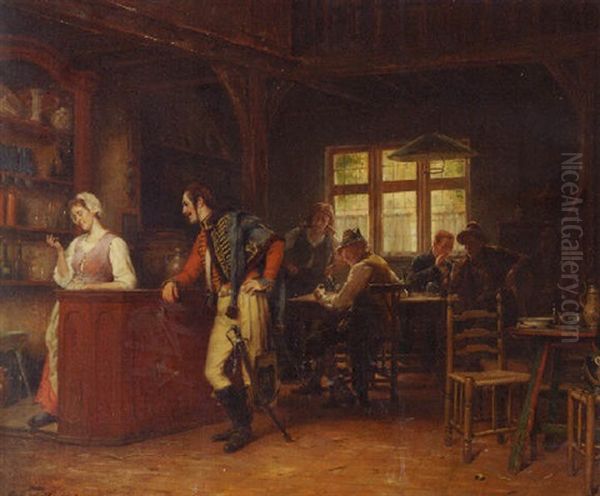
Several works stand out as representative of Gerard Jozef Portielje's style and thematic interests. "Een Gezellige Wijnproeverij" (A Pleasant Wine Tasting) exemplifies his skill in depicting convivial gatherings. This painting, measuring 38 by 46 centimeters and executed on panel, likely shows several gentlemen appreciating wine, perhaps in a cellar or a private room. The composition would focus on the figures' interactions and expressions, the details of their attire, and the surrounding environment, rendered with his characteristic precision. The estimated auction value of €6,000 to €8,000 reflects the market appreciation for such well-executed genre scenes.
Another notable work mentioned is "De bluffende jager" (The Boasting Hunter). This title suggests a narrative scene, likely featuring a hunter exaggerating his exploits, perhaps in a tavern setting to an amused or skeptical audience. Such anecdotal subjects allowed Portielje to explore characterisation and gentle humour. A painting with this title, measuring 34.5 by 46 centimeters, achieved a price of €4,500 at auction, indicating its appeal. These works highlight his ability to tell a small story within the confines of the canvas, engaging the viewer through relatable human interactions and detailed settings.
The painting titled "Drie Heren in Salon" (Three Gentlemen in a Salon), measuring 47.5 by 62 centimeters and signed with location "Antwerpen," also falls within his typical subject matter. It likely portrays a conversation or shared activity among three men in a well-appointed room, showcasing Portielje's talent for depicting masculine social rituals and detailed interiors. The estimated auction range of €4,000 to €6,000 further confirms the consistent demand for his work. Additionally, a work titled "Forty Winks" suggests a scene of quiet repose, perhaps depicting someone dozing off in a chair, showcasing a more intimate and informal moment. These examples underline his focus on bourgeois life, rendered with technical finesse.
Career, Activity, and Collaborations
Gerard Jozef Portielje was primarily active in his native Antwerp for much of his career. The city provided a supportive environment with patrons, galleries, and exhibition opportunities. His detailed, accessible style found favour with the local bourgeoisie, ensuring a steady demand for his work. However, his horizons extended beyond Antwerp. The provided information suggests he also spent time in Brussels and Paris, major European art centres. Exposure to the art scenes in these capitals likely broadened his perspectives, although his core style remained relatively consistent, rooted in the Belgian realist tradition.
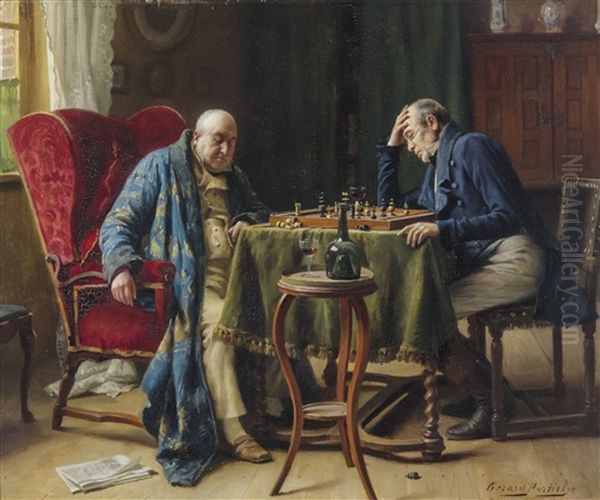
Interestingly, Portielje is known to have collaborated with other artists, a practice not uncommon at the time, especially for genre painters who might specialize in figures but rely on others for backgrounds or specific details. The sources mention collaborations with artists identified as E R Maes (likely Eugène Maes) and Frans Lebret (1820–1909). Frans Lebret was a Dutch painter known for his landscapes and animal scenes. Eugène Maes may have specialized in interiors or still life elements. These collaborations allowed Portielje to focus on his strength – the human figure and narrative composition – while ensuring the settings were rendered with complementary skill, resulting in a richer final product.
His participation in exhibitions, such as the Antwerp International Exposition, indicates his engagement with the broader art world and his ambition to reach wider audiences. These large-scale events were crucial for artists to gain recognition and attract patrons beyond their immediate circle. Portielje's consistent production and participation in the art market infrastructure of his time solidified his reputation as a reliable and skilled painter of genre scenes. He remained active into the early twentieth century, eventually passing away in Remich, Luxembourg, in 1929.
The Portielje Artistic Dynasty
Gerard Jozef Portielje was not an isolated figure but part of a notable artistic family. His father, Jan Frederik Pieter Portielje (1829–1908), established the family's artistic reputation. Jan Frederik was a successful painter in his own right, trained by Gustaf Wappers and Nicaise de Keyser at the Antwerp Academy. He specialized in portraits, often of an international clientele, and elegant genre scenes, sometimes with historical or exotic touches. His style combined Dutch precision with French Romantic flair, and he achieved considerable success, exhibiting internationally.
The artistic inclination continued with Gerard Jozef's generation. His younger brother, Edward Antoon Portielje (1861–1949), also became a painter, following a similar artistic path. Edward studied under his father and later under Charles Verlat at the Antwerp Academy. Like Gerard Jozef, Edward specialized in genre scenes, particularly interiors featuring elegant women. His style is often very close to his brother's, focusing on meticulous detail, rich fabrics, and intimate domestic settings. Edward also gained popularity, particularly for his depictions of Zeeland fisherwomen and charming coastal scenes, alongside the bourgeois interiors favoured by both brothers.
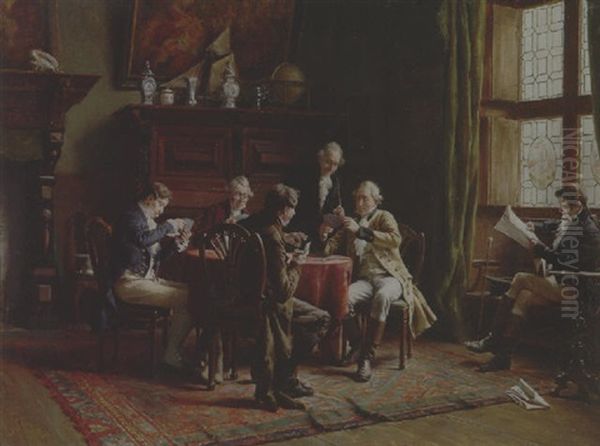
The existence of three successful painters within two generations – Jan Frederik Pieter, Gerard Jozef, and Edward Antoon – marks the Portieljes as a significant family in the context of nineteenth and early twentieth-century Belgian art. They shared a commitment to representational painting, technical skill, and themes drawn from everyday life and portraiture, catering to the tastes of a prosperous middle-class audience. Gerard Jozef, as mentioned, also mentored his son Edward, ensuring the continuation of the craft within the family, although the text seems to conflate his brother Edward (Antoon) with a potential son named Edward. Standard sources confirm Edward Antoon as his brother.
Contemporaries in the Belgian Art Scene
Gerard Jozef Portielje worked during a dynamic period in Belgian art, alongside numerous talented contemporaries who explored diverse artistic directions. Understanding this context helps situate his contribution. His father's teacher, Henri Leys (1815–1869), was a major figure in Belgian historical Romanticism and realism, whose influence lingered. In Antwerp, Henri de Braekeleer (1840–1888), Leys' nephew, developed a highly individual style of intimate interior scenes, known for their sensitive rendering of light and atmosphere, which offers an interesting comparison to Portielje's more polished interiors.
In Brussels, Alfred Stevens (1823–1906) achieved international fame for his depictions of elegant Parisian women in luxurious settings, a genre that resonates with some of Portielje's work, though Stevens often displayed a more modern, painterly touch. The darker side of Belgian life and the struggles of the working class were powerfully depicted by Constantin Meunier (1831–1905), known for his sculptures and paintings of miners and factory workers, representing a stark contrast to Portielje's comfortable bourgeois world. Similarly, Eugène Laermans (1864–1940) captured the hardships of rural life and emigration with expressive force.
The avant-garde was also active. James Ensor (1860–1949), based in Ostend, became a leading figure of Symbolism and Expressionism, famous for his grotesque masks and satirical paintings, radically different from Portielje's realism. Fernand Khnopff (1858–1921) was another key Symbolist, creating enigmatic and psychologically charged works. Belgian artists also embraced Impressionism and Neo-Impressionism; Emile Claus (1849–1924) became the leading figure of Luminism, capturing the effects of light in rural landscapes, while Théo van Rysselberghe (1862–1926) was a master of Pointillism.
Other notable contemporaries include Félicien Rops (1833–1898), known for his decadent and often controversial Symbolist works, primarily in printmaking. Léon Frédéric (1856–1940) combined realism with symbolic elements, often depicting large-scale scenes of rural life or allegories. The brothers David Oyens (1842-1902) and Pieter Oyens (1842-1894), Dutch painters active mainly in Brussels, were known for their intimate portraits and genre scenes, sharing some thematic ground with Portielje. This diverse group highlights the rich tapestry of Belgian art during Portielje's lifetime, ranging from academic tradition to radical innovation.
Later Life and Enduring Legacy
Gerard Jozef Portielje enjoyed a long and productive career, continuing to paint into the early decades of the twentieth century. His adherence to a detailed, realistic style meant his work remained accessible and popular with a segment of the art market, even as modernist movements gained prominence. He witnessed significant shifts in the art world but largely maintained the artistic path forged early in his career, refining his skills in depicting genre scenes that charmed with their narrative detail and technical polish.
He passed away in 1929 in Remich, Luxembourg. While specific details about his later years or potential shifts in his style are scarce in the provided information, his death marked the end of a career dedicated to the traditions of Belgian genre painting. He left behind a substantial body of work that continues to appear on the art market, regularly featuring in auctions across Europe. The consistent prices achieved for his paintings attest to an enduring appreciation for his craftsmanship and the nostalgic appeal of the world he depicted.
Gerard Jozef Portielje's legacy lies in his contribution to the rich tradition of Belgian genre painting. He may not have been an innovator who drastically altered the course of art history, but he was a highly skilled practitioner who excelled within his chosen field. His works offer valuable insights into the tastes, settings, and social customs of the Belgian bourgeoisie during the late nineteenth and early twentieth centuries. Alongside his father Jan Frederik and brother Edward Antoon, he represents the continuation of a family tradition dedicated to representational art, valued for its meticulous execution and relatable subject matter. His paintings remain appreciated by collectors and enthusiasts of nineteenth-century European realism.
Conclusion: A Master of Detail and Narrative
Gerard Jozef Portielje stands as a significant figure within the Antwerp school of painting during the late nineteenth and early twentieth centuries. As a member of a distinguished artistic family, he built upon the foundations laid by his father, developing his own distinct focus on genre scenes rendered with exceptional detail and clarity. His paintings, often depicting moments of conviviality, quiet domesticity, or gentle humour within bourgeois settings, found favour with contemporary audiences and continue to be sought after today.
His technical mastery, particularly in the rendering of textures, light, and human expression, is undeniable. While working within the bounds of academic realism, he imbued his scenes with narrative interest and psychological nuance. Collaborating with other artists like Eugène Maes and Frans Lebret further enriched his compositions. Situated amidst a vibrant Belgian art scene that included figures ranging from the realist Henri de Braekeleer to the symbolist James Ensor and the luminist Emile Claus, Portielje maintained his commitment to meticulous craftsmanship and accessible subject matter. His work provides a charming and insightful glimpse into the everyday life of his era, securing his place as a respected Belgian master of genre painting.